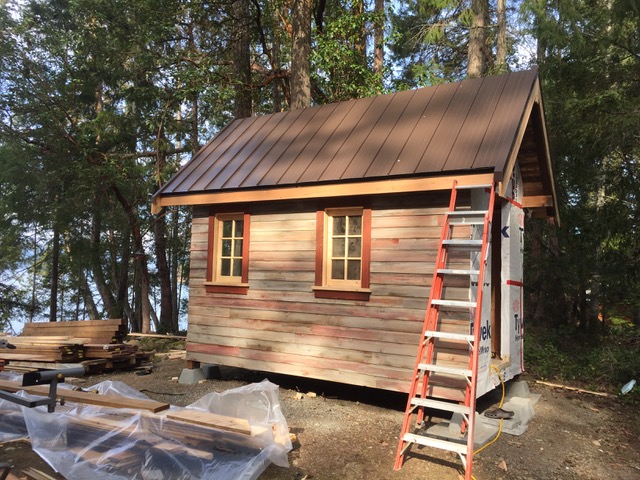Every day we hear how incredibly expensive and virtually unattainable basic housing is for so many people.
The result is young people mortgaging their lives for the dream of their own home, sky-high rental costs for all and increased homelessness. While government-led solutions like social housing and increased densification – strata projects, secondary suits, laneway housing, etc. – can help, high land costs and excessive permitting requirements are roadblocks.
Clearly, smaller, simpler, more affordable housing and creative land use solutions are needed.
The first basic question is, ‘How much space do you really need to live well?’
Cobble Hill’s Peerless Forest Products has unique – and stylish – approach.
“We’re kind of going back to the way houses were once commonly built: smaller-footprint, simple rectangular structures where a second floor or loft can be included or added as very low-cost living space,” says Peerless founder Jim Lambrick, who has spent more than 50 years in the local forest industry and creating quality products from local materials.

So what’s Peerless doing differently… and why is it a solution?
For more than a decade, Peerless has supplied post-and-beam-style kits primarily directed to backyard sheds, barns and utility applications. They’ve also designed and supplied complete houses.
That experience prompted the creation of the Cowichan Bunkies and Off-the-Grid Cabin Kits, useful for a variety of emerging needs – especially in communities like Cowichan, with many larger properties and acreages.
Possibilities include revenue-generating short-term vacation rentals and rental units for rural properties, off-grid cabins and recreational properties, and, yes, one part of the solution to housing shortage issues.
There are alternatives being created since the tiny home ‘movement’ is experiencing a revival of the ‘Park Model’ smaller mobile homes that have been around for over 70 years. These solutions rely on a set of wheels and a steel frame underneath… both expensive requirements before the structure build has even started. Factory build tiny homes cost anywhere from $70,000 and more typically cost over $90,000.
Lambrick suggests that you consider how mobile your tiny home actually needs to be. “How often do you expect to move your tiny home? For many buyers, they are looking for a small cabin to rent as additional income on their property, so it is unlikely to move,” explains Lambrick.
“If an owner plans to move frequently, then a tiny home on a trailer base is the right choice.”
Even without the increased investment in a trailer base, Peerless bunkies and off-grid models can be disassembled and moved anyway. The lower initial cost means a revenue unit is paying off sooner.

So how much is a Bunkie or Off-Grid?
Although Peerless does sell the 107sqft Bunkie as a do-it-yourself kit at a considerably reduced cost, most people prefer a fully wired and insulated model with basic finishings which falls in the $18,000-$22,000 range.
Off-Grids will typically cost around $150 per square foot compared to the $300-$350 for tiny homes built on a wheeled frame. A 10x20sqft model will come in at approximately $30,000.
The new Peerless Post-Pedestal Structures, currently ranging from the 107sqft Bunkies (no permit required in most jurisdictions) to 800 sqft Off-Grid cabins, are primarily applied to residential uses.
Here’s why it works:
- No complex or expensive foundations needed – The post-pedestal design uses structural posts extended to temporary or poured concrete footings. In remote sites, where concrete is expensive and challenging, this allows for simple local mixer pours. Hardware store concrete pier blocks ($8 each) are fine for most locations.
- Solution for challenging sites – Well-adapted to steep slopes, rocky and difficult sites, the design is particularly suited for wet or flood-prone areas – just elevate the entire house on concrete post pedestals to suit the local risk. The floor is suspended from the posts and when the whole unit is framed in and sheeted, it makes for an incredibly strong box-like structure that can be moved if required.
- Practical benefits – The heavy post-and-beam style kits, assembled with heavy screw fasteners and structural connector plates, offer a timber frame look without the timber frame-intensive labour cost. For ongoing savings, the steep-pitched roof is ideal for solar panel installation, optimizing solar collection in low sun seasons and clears snow cover faster.
- DIY friendly – Get the basic structure kit and do the rest yourself! Inframing between posts is standard 2×4 or 2×6 to suit specific customer requirements. Ideal for using cheaper recycled components such as doors and windows.
- Design flexibility – The post-pedestal concept allows for bed-lofts or a complete second storey, and traditional covered porches or decks to increase available living space at low added cost. Give your new home a custom finish with Peerless’s Shou-sugi-ban siding, barn board, solid wood flooring and paneling, all Canadian-origin solid wood products sourced from local suppliers. In fact, ALL Peerless interior and exterior finishing products are 100 per cent unique, local and not available at big box stores.
- Mobility – Structures can be supplied as pre-assembled components which can be easily transported by a crane truck which can reassemble the parts once delivered. The bunkies, for example, consist of the box base and a prebuilt roof unit delivered as two components. At the site the box base unit is quickly installed and then the roof is lifted and fitted on like a hat. Disassembly is just as easy.












